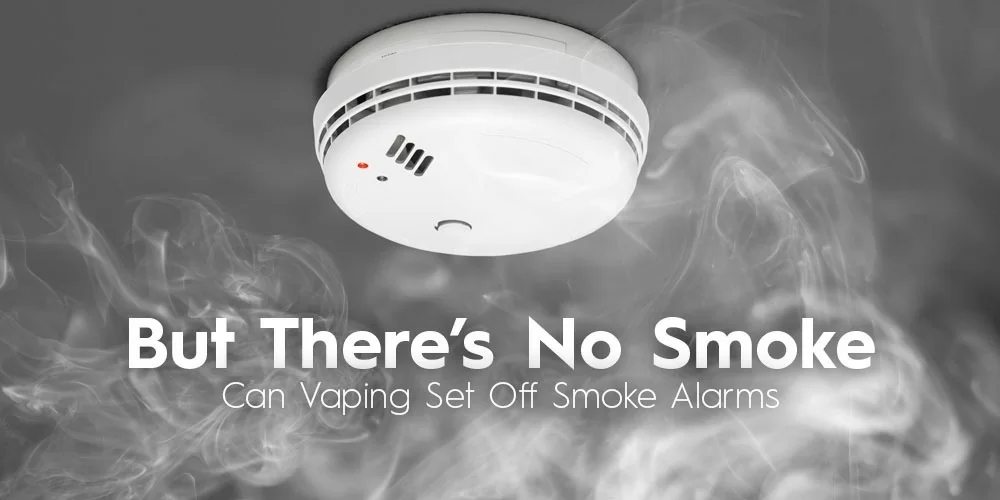Can You Vape on Accutane?
For people who vape, a common question arises early in treatment: can you vape on Accutane, and is it safe to do so?
Read More >>WARNING: THIS PRODUCT CONTAINS NICOTINE. NICOTINE IS AN ADDICTIVE CHEMICAL.
Do you have a smoke alarm in your home that you don't want to set off when you vape? Or are you just curious if vapour from an e-cigarette can actually set off a smoke alarm? Either way, you're not alone. To help answer these questions, we've put together this comprehensive guide to smoke alarms and vaping. Let's start with the basics.

Vaping can absolutely set off a smoke alarm, however, not all smoke detectors are sensitive to vapour. First of all, there are three types of smoke alarms:
There are three main kinds of smoke alarms, and they vary in sensitivity when it comes to vapor:
Heat alarms, also called rate-of-rise detectors, are triggered by sudden increases in temperature rather than smoke particles. They likely won't detect the relatively cool vapor produced by vaping. Heat alarms are common in kitchens.
Ionization alarms use a small amount of radioactive material to ionize air molecules and detect disruptions when smoke enters. Denser vape clouds can potentially set them off, but they're less sensitive than optical models overall. They are found in many offices and public buildings.
Optical smoke alarms use a light beam and sensor to detect particles. The vape aerosol can reflect and scatter the light enough to activate the alarm if it is dense enough. Optical models are the most sensitive and commonly used in homes.
| Type | Sensitivity | Where you may see it |
| Heat alarms | Unlikely to detect vapour | Kitchens |
| Ionisation alarms | Less likely to be activated from vapour | Public buildings and offices |
| Optical smoke alarms | The most sensitive to vapour | Home |
While occasional false alarms from vaping may be inevitable, there are ways to minimize the nuisance. Here are some tips to stop your vape from triggering smoke detectors:
Vape in open, ventilated spaces like a room with an open window or door to allow vapor to readily dissipate instead of concentrating. Avoid small enclosed areas where vapor is more likely to be detected.

Keeping a reasonable distance from smoke detectors when exhaling vapor reduces the risk of the concentrated cloud reaching the sensors. Avoid vaping right next to detectors.
As we noted above, some smoke alarms can detect the vapour from e-cigarettes. For those that want to know how to avoid setting off a smoke alarm when vaping, here are some techniques and products that may help you avoid triggering an alarm:
Vape juice is often made with both vegetable glycerine and propylene glycol, known commonly in the world of vaping as VG and PG. As vegetable glycerine produces a thicker cloud of vapour than propylene glycol, using a vape juice that contains more PG than VG can help reduce the chances of setting off a smoke alarm.
High-powered vapes might be great for vaping but the large clouds that they're capable of producing might work against you if you're trying to avoid triggering a smoke alarm. A low-powered device like a pod vape, especially one that allows you to adjust the wattage or voltage, can help reduce the risk of setting off an alarm.
Vaping in an area that is properly ventilated can work wonders when it comes to avoiding triggering an alarm. A properly ventilated area will help dissipate any vapour in the air, making it less likely to set off an alarm.
Pod systems are sometimes designed to produce less vapour. While many vapers prefer more vapour, there is no shortage of those who prefer less. Subsequently, there are a number of vaping devices on the market that are capable of producing minimal vapour. While our own Sikary vape pen is capable of producing thick clouds of vapour, its airflow and wattage adjustments make it possible to calibrate its vapour production to produce less vapour.
Two other options that are available on the market are stealth vapes, which are sometimes known as vapourless vapes, and vapourless vape juice, both of which are designed to produce less vapour. With "vapourless" vape juice, significantly more propylene glycol is used in place of vegetable glycerin to achieve minimal vapour production when vaped.
There are a number of different active and passive air filters available on the open market that can help capture vapour and prevent it from reaching a smoke detector and triggering the alarm. There are even filters designed specifically for capturing smoke, which can also work with vapour. These types of filters often employ a combination of filtration and adsorption to reduce the amount of smoke or vapour particles in the air, reducing the likelihood that your vapour will set off a smoke alarm.